See details
READ MORE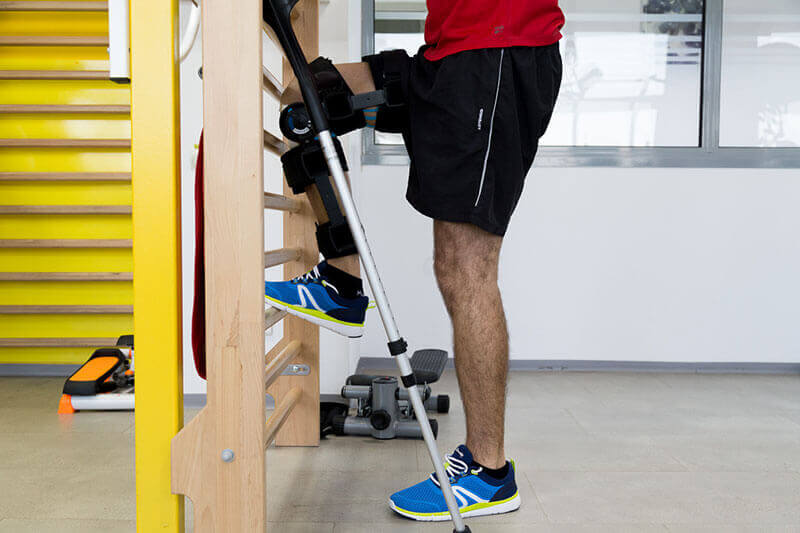
Recovery of the prosthetic knee
The duration of hospitalization is 7 to 14 days, depending on the immediate evolution of the patient, how the recovery begins. Before discharge, the patient must be able to perform the following movements: get out of bed and sit in bed without help, move with crutches or a frame, be able to do the exercises recommended by the physiotherapist who helped him throughout. hospitalization.In the first 6 weeks, it is essential to follow the doctor's advice and perform the exercises under the guidance of the qualified staff (physical therapist). General principles of operation care:
- The dressing applied at the hospital must be clean and changed whenever needed.
- The patient is forbidden to take a shower or bath before removing the sutures 14 days after the operation. The incision site should be kept clean and dry.
- Tell your doctor if the bandage is stained, the skin changes color, the area is warmer, the temperature is cold, there is burning urination, leg or thigh swelling, or pain.
- Take your temperature twice a day (morning and evening).
- Take the prescribed medication when you leave the hospital. The medicines will be administered strictly according to the indications of the attending physician. You will receive anti-coagulants to prevent the formation of blood clots in the veins of your calves or thighs because they are life-threatening. In addition, you will receive an anti-inflammatory for 7 days and an analgesic (pain medicine) if needed. You will need to take antibiotics whenever there is a danger of a bacterial infection, for example, pharyngitis, bronchitis, dental abscess, periungual panaritium.
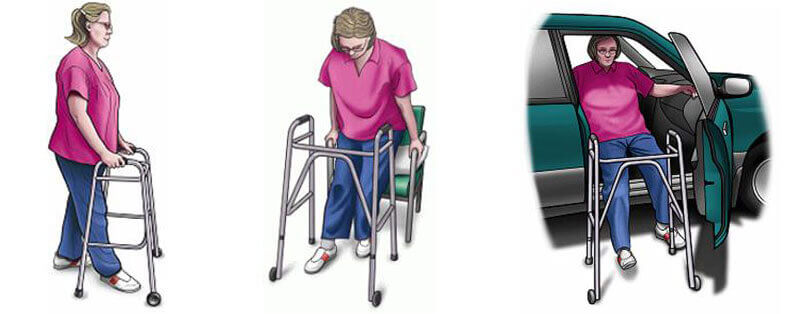
Avoid:
- Do not cross your legs for at least 2 weeks.
- Do not bend your knee above the hip.
- Do not bend forward while sitting or sitting.
- Do not try to take anything off the floor while sitting.
- Do not force your feet to turn inward or outward when bending over.
- Do not lie down to grab the blanket when you are in bed (from a horizontal position).
- Do not stand with your toes turned inward.
- Do not use your pain as a clue as to what you can or cannot do.
Useful advice:
- The walk is resumed immediately, but with the help of a frame. Within the limits of pain tolerability, the distance traveled by the patient will increase progressively. The loading on the operated limb is done with all the weight.
- You can give up the walking frame after 6 weeks.
- Sleep with your affected leg up on a pillow.
- Climbing stairs must be avoided until complete healing (8 weeks).
- If climbing stairs is inevitable: first put your healthy foot on the step, then raise the operated leg to the same level, then bring the cane or crutches on the same step, and to go down, repeat the reverse process.
- Nutrition is normal, but in the case of an overweight person, weight loss is essential to protect the prosthesis.
- That is why we advise you to change your lifestyle, diet by replacing dietary fats with fiber, fruits, vegetables. We recommend the administration of iron and vitamin supplements. To avoid overloading the joint, it is recommended to avoid alcohol consumption.
- Sexual activity can be resumed safely at 4 to 6 weeks after surgery.
- Driving can be resumed 6 weeks after surgery.
- Use a shower chair or a support bar.
- Swimming is recommended, immediately after removing the sutures and healing the incision, approximately 4 weeks after the operation.
- Walk as much as you can, but keep in mind that walking should not replace the recommended exercises.
- Avoid activities that put high pressure on the joint, contact sports.

Stages of the recovery protocol
STAGE I: WEEK 1
- Lifting safely to the edge of the bed
- Resume safe walking with the help of the walking frame
- Static and dynamic balance with the help of the metal frame
- Full extension and 100 degrees flexion
- The passive movement continues postoperatively
- Ice locally for 20 minutes every 1-2 hours
- A towel rolled under the ankle during periods of rest
- Progressive passive movement progresses by 10 degrees or more, every day, to flexion of 100 degrees
- Ice locally for 15 minutes at least 3 times a day
- Exercises in bed: flexion of the ankle extension, active extension of the knee (quadriceps), active flexion of the knee with sliding of the heel on the bed.
- Sitting position at the edge of the bed, with help
- Walking with the metal frame
- Sitting in the chair for 15 min
- Active knee movement 0-70 degrees
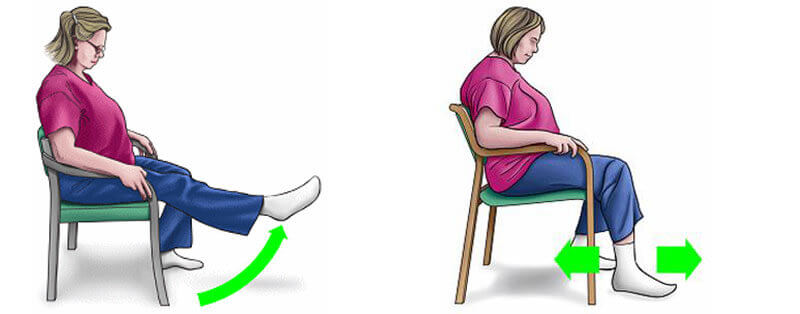
Day 2:
- Continuing the exercises with improving the range of motion, walking correctly with the walking frame
- Exercises in bed, 5 times a day
- Walking with walking frame 75-100 min under supervision
- Going to the toilet and practicing the transfer from the bed, and on the toilet seat
- Sitting 30 min twice a day in a chair (+ during the meal)
- Active knee movement 0-80 degrees
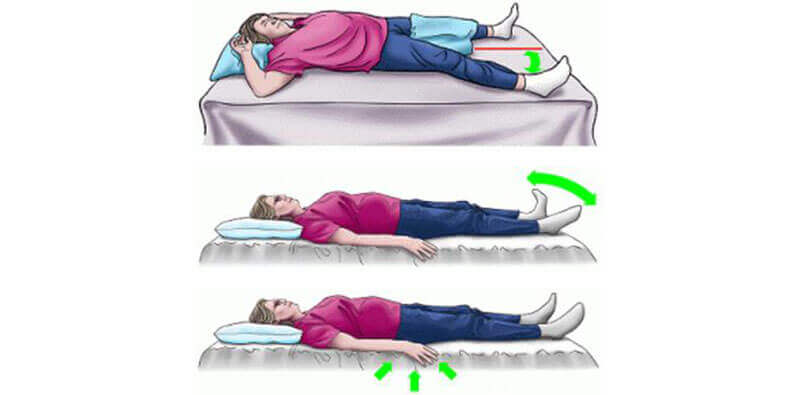
Day 3:
- Continue the exercises
- Getting out of bed under supervision
- Walking with walking frame 150min under supervision
- 4 steps with help
- Hip flexion and knee flexion in a standing position
- Sitting 45 minutes in the chair as many times a day
- Use of the toilet with supervision
- Active knee movement 0-90 degrees
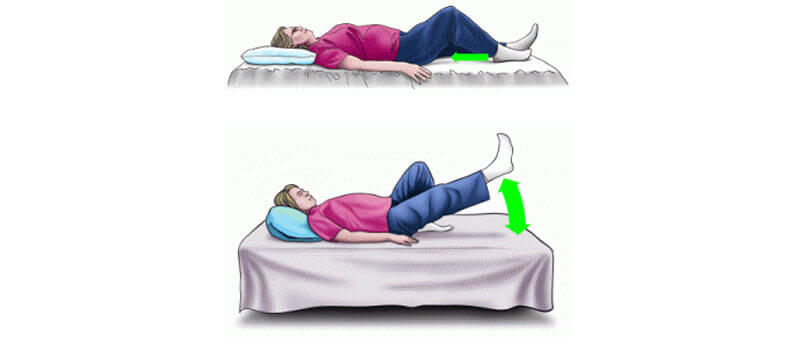
Day 4:
- Continue the exercises
- Transfer from bed without help
- Walking with walking frame 300min
- 4-8 steps with help
- Sitting most of the day in the chair, with pauses to stretch the operated leg every 45 minutes
- Active knee movement 0-95 degrees

Day 5:
- Continue the exercises
- Walking with walking frame 400min
- Climbing/descending stairs with metal frame
- Active knee movement 0-100 degrees
- Discharge day

STAGE II: PROGRESSIVE FUNCTIONAL RECOVERY (weeks 2-5)
- Replacing the walking frame with a crutch or cane
- Improving muscle strength and proprioceptive functions
- Improving balance while walking
- Resumption of activity in the house
- Checking the surgical wound and the presence of inflammation, suppression of sutures
- Continuing the exercises at home
- Extending the walking distance
- Start the medical bike for 5-10 minutes with supervision
- Balance exercises
- Range of motion of 0-115 degrees
- Continuation of the exercises
- Walking with the cane
- Medicinal bicycle 10-12 min, 2 times a day
- Balance in the affected leg
- Kneeling (body weight only)
- Range of motion of 0-120 degrees
- Continuation of the exercises
- Walking with the cane
- Medicinal bicycle 15 min, 2 times a day
- The side step exercise is introduced
- Range of motion of 0-125 degrees
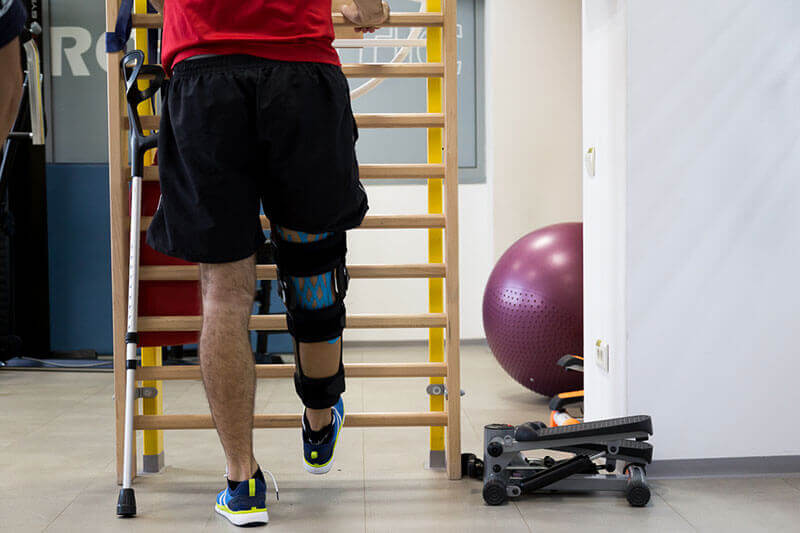
STAGE III: ADVANCED RECOVERY PROGRAM
- Walking without help
- Normal static and dynamic balance
- The maximum amplitude of movements
- Continuation of the exercises
- Walking without help
- Emphasis is placed on exercises for muscle toning. No weights are added until the surgeon is consulted
- Reaching a range of motion of 0-135 degrees
- Continuation of toning and resistance exercises

MAKE AN APPOINTMENT
CONTACT US
SUCCESSFUL RECOVERY STORIES
MAKE AN APPOINTMENT
FOR AN EXAMINATION
See here how you can make an appointment and the location of our clinics.
MAKE AN APPOINTMENT




































































































































